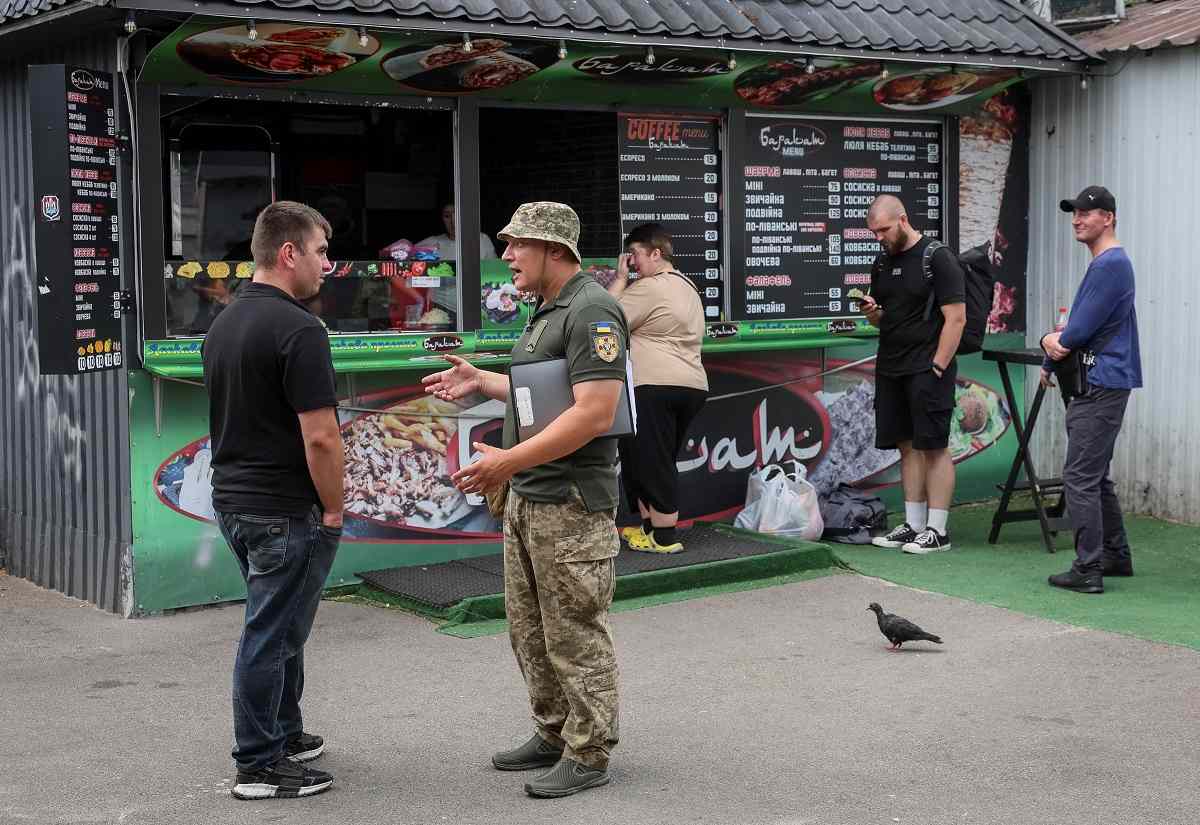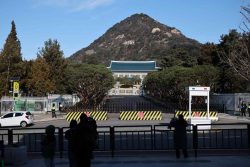
A recruiters officer with the call sign ‘Fantomas’ speaks with a man on a street as he checks papers of men and hands out military summonses, amid Russia’s attack on Ukraine, in Kyiv, Ukraine July 3, 2024.
12:30 JST, July 16, 2024
KYIV (Reuters) – Seeing the military patrol handing out call-up papers on the outskirts of Kyiv, one man slipped into a nearby store. Another refused to even stop for the officers. Others, however, quietly obliged.
While men may be coming round to Ukraine’s ramped-up mobilization drive to replenish troop numbers more than 28 months since Russia’s invasion, they are less eager to fight than before, said a draft officer, who uses the call sign “Fantomas.”
“Now, as far as I know, most of the queues (at draft offices) are people who want to obtain some sort of exemption (from fighting),” said the 36-year-old, who was accompanied by Reuters on a recent draft patrol in the Ukrainian capital.
The combat veteran is on the front lines of the effort to redouble the draft despite waning public enthusiasm for wartime service as military analysts describe regenerating troop manpower as one of Kyiv’s central battlefield challenges.
President Volodymyr Zelenskiy lowered the draft age to 25 from 27 in April and signed off on an overhaul of the mobilization process that entered force in May, obliging men under 60 to renew their personal data at draft offices or online.
Though recruitment numbers remain shrouded in wartime secrecy, some political and military officials have said the changes, including a campaign to increase voluntary recruitment, have got the mobilization effort back on track after two months.
The Ukrainian military told Reuters in a written statement that the conscription rate had more than doubled in May and June compared to the previous two months, without providing the figures.
Spokesperson Bohdan Senyk described that as a “positive trend.” The average age of a mobilized soldier remained unchanged at around 40.
DEMOBILISATION
Strengthened by long-delayed Western aid, Ukraine’s forces have struggled for months to hold the line against Russian troops inching forward in the east.
Many weary troops are desperate to be replaced after more than two years of virtually non-stop service with no clarity on when they will be demobilized from an armed forces of around 1 million.
Asked about a figure of 200,000 additional troops cited in a German newspaper, Roman Kostenko, secretary of parliament’s national defense committee estimated that the military could enlist that many by the year’s end if the process continued at its current pace.
That, he said, could allow Ukraine to consider legislation to demobilize some troops, though the interior minister warned doing so without replacing a proportional share of them could weaken the front.
Mathieu Boulègue, a defense analyst for the Washington-based Center for European Policy Analysis, said the 200,000 estimate was encouraging but that the more critical task would be training them and distributing them to the front correctly.
Ukraine needs to “invest human capital smartly and efficiently where it is needed. Because in as much as you can get anyone to drive a truck or clean toilets, you can’t get effective warfighters that easily,” he said.
Russia, meanwhile, is recruiting around 30,000 troops per month for its war effort while suffering “very high” losses, a senior NATO official said on Tuesday. He added that Moscow lacked the munitions and troops to start a major offensive.
PUBLIC MISGIVINGS
Since the mobilization overhaul, some draft offices have struggled to cope with the influx of men who have come to register or update their data by the July 16 deadline.
“More people are coming than we are able to accept,” said a deputy head of the draft office where Fantomas works. “Sometimes processing drags on to 1 o’clock at night.”
The official, who requested anonymity, echoed Fantomas and said a “very, very big” portion of men were seeking exemptions, though he insisted things were on track.
“We’re fulfilling our assigned tasks. I wouldn’t say to 100%, but not bad.”
Reports of draft corruption and social media footage of scuffles between recruiters and citizens soured the public mood in the lead-up to the springtime rule changes.
In an April survey commissioned by public broadcaster Suspilne, around 50% of Ukrainians said they believed mobilization was going poorly, and 60% said they had a negative perception of draft offices.
Facing public opposition, lawmakers stopped short of pushing through more severe sanctions against draft-dodgers as part of the overhaul.
Fantomas, who was wounded in eastern Ukraine last year, said 70% of his interactions with people he approaches on the street are positive.
He and other military officials have said conflicts such as those captured on film are rare, often torn out of context and exploited by pro-Russian accounts to discredit recruiters, but have been successful in blunting enthusiasm.
He admitted he had once been attacked on patrol, but said he refused to fight back for fear of being caught on camera.
“The one part where I would be defending myself would make it into a video, and only that would be made to go viral.”
"News Services" POPULAR ARTICLE
-

American Playwright Jeremy O. Harris Arrested in Japan on Alleged Drug Smuggling
-

Japan’s Nikkei Stock Average as JGB Yields, Yen Rise on Rate-Hike Bets
-

Japan’s Nikkei Stock Average Licks Wounds after Selloff Sparked by BOJ Hike Bets (UPDATE 1)
-

Japan’s Nikkei Stock Average Buoyed by Stable Yen; SoftBank’s Slide Caps Gains (UPDATE 1)
-

Japanese Bond Yields Zoom, Stocks Slide as Rate Hike Looms
JN ACCESS RANKING
-

Keidanren Chairman Yoshinobu Tsutsui Visits Kashiwazaki-Kariwa Nuclear Power Plant; Inspects New Emergency Safety System
-

Tokyo Economic Security Forum to Hold Inaugural Meeting Amid Tense Global Environment
-

Imports of Rare Earths from China Facing Delays, May Be Caused by Deterioration of Japan-China Relations
-

University of Tokyo Professor Discusses Japanese Economic Security in Interview Ahead of Forum
-

Japan Pulls out of Vietnam Nuclear Project, Complicating Hanoi’s Power Plans























